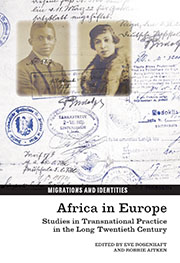Book contents
- Frontmatter
- Contents
- Acknowledgements
- List of Illustrations
- List of Abbreviations
- List of Contributors
- 1 Introduction
- I Enacting Identity: Individuals, Families and Communities
- II Authenticity and Influence: Contexts for Black Cultural Production
- III Post-colonial Belonging
- IV Narratives/Histories
- 12 Middle Passage Blackness and its Diasporic Discontents: The Case for a Post-War Epistemology
- 13 Black and German: Filming Black History and Experience
- 14 Excavating Diaspora: An Interview Discussing Elleke Boehmer's Novel Nile Baby
- 15 Afterword
- Bibliography
- Index
15 - Afterword
from IV - Narratives/Histories
- Frontmatter
- Contents
- Acknowledgements
- List of Illustrations
- List of Abbreviations
- List of Contributors
- 1 Introduction
- I Enacting Identity: Individuals, Families and Communities
- II Authenticity and Influence: Contexts for Black Cultural Production
- III Post-colonial Belonging
- IV Narratives/Histories
- 12 Middle Passage Blackness and its Diasporic Discontents: The Case for a Post-War Epistemology
- 13 Black and German: Filming Black History and Experience
- 14 Excavating Diaspora: An Interview Discussing Elleke Boehmer's Novel Nile Baby
- 15 Afterword
- Bibliography
- Index
Summary
Since the convening of the conference ‘Africans in Europe in the Long Twentieth Century’, the northern stretch of the African Continent has changed it spots, its colours no longer recognisable, as the Tunisian and Egyptian springs cast shadows across the terrain from the Mediterranean to the Red Sea and beyond. In the wake of the conference, NATO planes bombed Tripoli and the divisions among African peoples became sharply discernible: migrant worker refugees fled south to the Sub-Saharan nations and north to Italy from makeshift shelters, discarded by employers and states which exploited their labour in better economic times, and were pursued as villains when the political guard changed hands. One asked: who is African and who is European, in the quickly altering circumstances of pro- and anti-NATO action, and the onset of revolutionary violence? It is now as if the conference had in some respects documented a world already vanished – issues and peoples that remained invisible in those rainy days in Liverpool erupting from underground to take centre stage in events that will affect any future conversations. In the rapid fire of actions on so many fronts of the two changing continents, what can be savoured from what was said and written in the months between the autumn of 2009 and the ‘Arab Spring’? How can these essays serve as guides to subsequent researchers, even as we recognise that history will not be made as we choose?
- Type
- Chapter
- Information
- Africa in EuropeStudies in Transnational Practice in the Long Twentieth Century, pp. 261 - 268Publisher: Liverpool University PressPrint publication year: 2013



